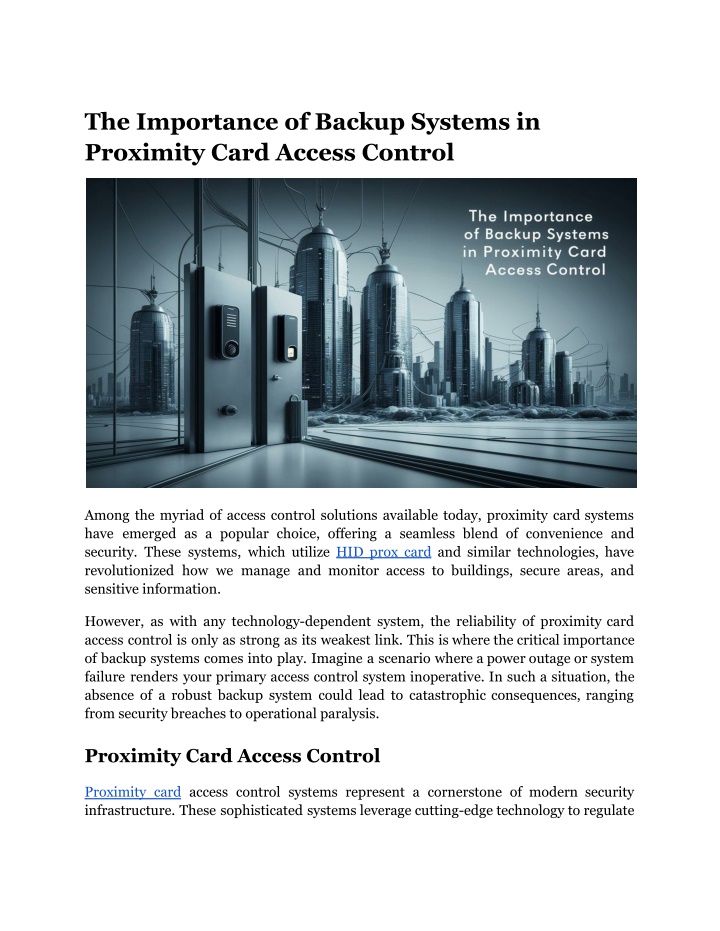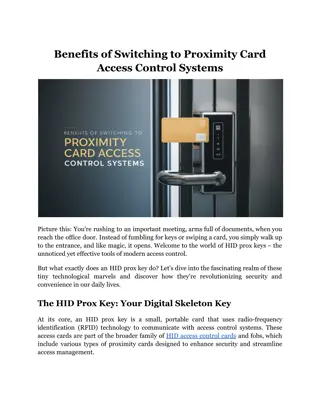
The Importance of Backup Systems in Proximity Card Access Control
Discover why backup systems are crucial for ensuring security and reliability in proximity card access control.
Download Presentation

Please find below an Image/Link to download the presentation.
The content on the website is provided AS IS for your information and personal use only. It may not be sold, licensed, or shared on other websites without obtaining consent from the author. If you encounter any issues during the download, it is possible that the publisher has removed the file from their server.
You are allowed to download the files provided on this website for personal or commercial use, subject to the condition that they are used lawfully. All files are the property of their respective owners.
The content on the website is provided AS IS for your information and personal use only. It may not be sold, licensed, or shared on other websites without obtaining consent from the author.
E N D
Presentation Transcript
The Importance of Backup Systems in Proximity Card Access Control Among the myriad of access control solutions available today, proximity card systems have emerged as a popular choice, offering a seamless blend of convenience and security. These systems, which utilize HID prox card and similar technologies, have revolutionized how we manage and monitor access to buildings, secure areas, and sensitive information. However, as with any technology-dependent system, the reliability of proximity card access control is only as strong as its weakest link. This is where the critical importance of backup systems comes into play. Imagine a scenario where a power outage or system failure renders your primary access control system inoperative. In such a situation, the absence of a robust backup system could lead to catastrophic consequences, ranging from security breaches to operational paralysis. Proximity Card Access Control Proximity card access control systems represent a cornerstone of modern security infrastructure. These sophisticated systems leverage cutting-edge technology to regulate
and monitor access to physical spaces, providing a seamless blend of convenience and robust security. At its core, a proximity card system consists of several key components working in harmony. Each element plays a crucial role in ensuring the system's effectiveness and reliability. Proximity Card Technology: At the heart of these systems are 125 KHz proximity cards, which use radio frequency identification (RFID) to communicate with card readers. Card Readers: These devices detect and interpret the signals emitted by proximity cards, granting or denying access based on predefined permissions. Access Control Panels: The central hub that processes information from card readers and manages access permissions. Software: Sophisticated programs that allow administrators to manage user credentials, monitor access events, and generate reports. Network Infrastructure: The backbone that connects all components of the access control system. Read More Article: Exploring the Use of Proximity Cards for Visitor Management Types of Proximity Cards Several types of proximity cards are available in the market, each with its unique features and applications: HID ProxCard II: One of the most widely used proximity cards, the HID prox card ii offers reliable performance and compatibility with a wide range of readers. 26 Bit Cards provide a standard format for encoding user information, making them a popular choice for many organizations. Customized Cards: A reputable proximity card supplier offers tailored solutions to meet specific organizational needs. Bristol ID Technologies, a leading provider in the industry, offers a wide range of proximity card solutions like 26 Bit Proximity Cards to suit various security requirements. The Critical Need for Backup Systems The importance of backup systems in proximity card access control cannot be overstated. Here's why:
Continuous Operation: Ensures that access control remains functional even during primary system failures. Data Protection: Safeguards critical access logs and user information from loss or corruption. Security Maintenance: Prevents downtimes. Compliance: Helps organizations meet regulatory requirements for continuous security measures. Business Continuity: Minimizes disruptions to operations and productivity. unauthorized access during system Potential Risks of Inadequate Backup Systems Risk Consequence Mitigation Power Failure Complete shutdown system Uninterruptible Supply (UPS) Power Data Loss Loss of access logs and user credentials Regular data backups and redundant storage Hardware Failure Inability to process access requests Redundant components hardware Network Outage Communication breakdown system components Offline mode capabilities and local caching between Software Corruption System potential vulnerabilities instability and Regular software updates and backup copies security Types of Backup Systems for Proximity Card Access Control 1. Power Backup Solutions Ensuring continuous power supply is paramount in maintaining the integrity of access control systems. Power backup solutions come in various forms: Uninterruptible Power Supply (UPS) systems Backup generators
Solar-powered backup systems These solutions provide a critical safety net during power outages, preventing security breaches and maintaining operational continuity. 2. Data Backup Solutions In the digital age, data is the lifeblood of access control systems. Protecting this valuable information is crucial for system integrity and compliance. Data backup solutions include: Cloud-based backups On-site redundant servers Offline data storage By implementing robust data backup strategies, organizations can safeguard against data loss and ensure quick recovery in case of system failures. 3. Hardware Redundancy Physical components form the backbone of proximity card access control systems. Hardware redundancy ensures that the failure of a single component doesn't compromise the entire system. Key elements of hardware redundancy include: Duplicate access control panels Redundant card readers Spare HID prox card 2 inventory This approach minimizes downtime and maintains security even when individual hardware components fail. 4. Network Redundancy In our interconnected world, network reliability is crucial for the seamless operation of access control systems. Network redundancy provides multiple pathways for data transmission, ensuring uninterrupted communication. Common network redundancy strategies include: Multiple Internet service providers Cellular backup connections
Mesh network configurations By implementing these solutions, organizations can maintain system functionality even during network outages or disruptions. 5. Software Backup The software that powers proximity card access control systems is just as critical as the hardware. Protecting against software failures and corruption is essential for maintaining system integrity. Software backup solutions encompass: Regular system image backups Virtualized access control software Offline mode capabilities These measures ensure that the system can be quickly restored to a known good state in case of software issues, minimizing security risks and operational disruptions. Implementing an Effective Backup Strategy To ensure the robustness of your proximity card access control system, consider the following steps: Risk Assessment: Identify potential vulnerabilities in your current system. Comprehensive Planning: Develop a backup strategy that addresses all aspects of your access control infrastructure. Regular Testing: Conduct periodic tests of your backup systems to ensure their effectiveness. Employee Training: Educate staff on backup procedures and emergency protocols. Documentation: Maintain detailed records of your backup systems and procedures. Continuous Improvement: Regularly review and update your backup strategy to address emerging threats and technological advancements. Best Practices for Backup System Maintenance Schedule regular maintenance checks for all backup components. Keep firmware and software up-to-date on all devices. Regularly rotate and test backup batteries.
Conduct periodic audits of your backup systems' performance. Maintain a stock of essential spare parts, including HID prox cards. Read More Article: Choosing Between Proximity Cards and Biometric Systems Emerging Trends in Access Control Backup Systems As technology continues to evolve, so do the solutions for ensuring the reliability of access control systems: Cloud-Based Backup Solutions: Offering scalable and easily accessible data storage options. AI-Powered Predictive Maintenance: Utilizing artificial intelligence to anticipate and prevent system failures. Blockchain for Data Integrity: Employing blockchain technology to ensure the immutability of access logs and user credentials. Biometric Integration: Combining proximity card technology with biometric verification for enhanced security and redundancy. IoT-Enabled Monitoring: Leveraging the Internet of Things for real-time system health monitoring and automated backup triggering. Wrapping Up Investing in robust backup systems for proximity card access control is a strategic imperative for any organization committed to safeguarding its future. As a leading proximity card supplier, our specialists at Bristol ID Technologies understand that security is about creating comprehensive systems that protect assets, streamline operations, and enhance user experience. Our range of proximity card solutions exemplifies this philosophy: We provide Prox Card II HID known for its reliability and wide compatibility. 26 Bit Proximity Cards: Our selection includes these versatile cards, perfect for standardized systems. Custom Proximity Cards: We specialize in tailoring solutions to meet your unique security requirements. Each product is designed with precision, incorporating the latest advancements in security features and durability.
Site Article: The Importance of Backup Systems in Proximity Card Access Control






















